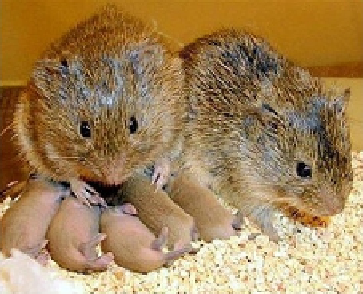Biology Reference
In-Depth Information
Figure 4.17
Prairie voles parenting their puppies.
http://jeancmiranda.blogspot.com/
There are numerous examples demonstrating that a species performs an innate
behavior that another closely related species does not and cannot although the latter
has all the genes needed to perform the behavior.
We will illustrate this with the case of the social bonding that only some voles
display. The prairie vole,
Microtus ochrogaster
(family Muridae, subfamily
Arvicolinae), is a native small mammal of North America. This is a monogamous
species that forms enduring pair bonds between mates (
Young et al., 1998, 2001
).
They share a nest during the breeding season and remain together for life (
Wang
and Aragona, 2004
). The male partner displays parental care and mate guarding. A
closely related vole species, the montane vole,
Microtus montanus
, is polygamous
and does not display parental care (
Figure 4.17
).
The social attachment in the prairie vole is related to the brain reward system with
the nucleus accumbens (NAcc) as a central player. The most relevant changes at the
molecular level occur in NAcc and related brain regions and involve neuropeptides
oxytocin and AVP and DA. Within 3 days of cohabitating with a female, an increase
of AVP mRNA in the bed nucleus of the stria terminalis (BST) and a decrease in the
lateral septum (LS) occurs in males. The expression of receptors for AVP and for
oxytocin is different in the relevant regions in monogamous and polygamous voles
(
Wang and Aragona, 2004
). Prairie voles have more receptors for vasopressin in
the NAcc (
Figure 4.18
). DA activates D2-type receptors and is crucial to the role of
NAcc in vole monogamous behavior (
Wang and Aragona, 2004
). DAergic neurons
are present in other adjacent brain regions (
Young et al., 2008
).
Experimental evidence showed that DA antagonists block mating-induced part-
ner preferences, whereas DA agonists induce it in the absence of mating (
Aragona
et al., 2003
). Expression of the DA receptor D2R in NAcc facilitates bond formation
(
Young et al., 2011
).
No functional differences exist between neuropeptides AVP and oxytocin between
monogamous and polygamous voles. The only differences between them are differ-
ences in the
expression
of receptors for AVP, oxytocin and DA (i.e., the epigenetic
differences in their brains).

Search WWH ::

Custom Search